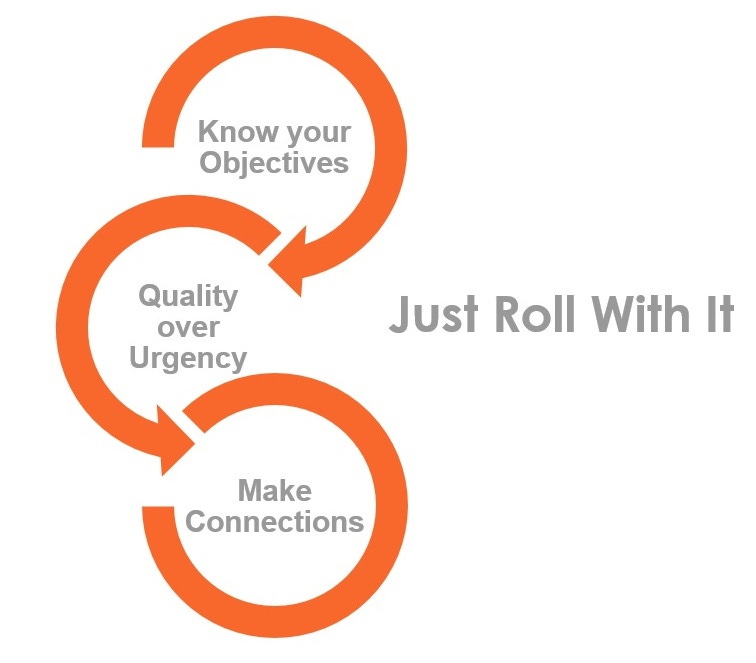Just Roll With It
Turning challenges into wins
You are preparing for a customer presentation that starts in 15 minutes. Your boss pings on instant messaging. Do you ignore your boss or respond?
You've been waiting for your engineering team to test a feature that wasn't delivered last release. Do you send a note to the head of engineering about the miss or do you re-prioritize the feature to the top of your backlog?
You have a dependency on end-to-end testing of your cloud-based service and your test team believes this is out of their scope. Do you accept their limited test plan or do you prepare end-to-end testing requirements?
You are a busy person and each situation is adding more work that you simply can't absorb any more. It turns out that you can adapt and absorb much more than you think is possible! There are a few ways to roll with the daily challenges:
Know your objectives
Put quality ahead of urgency
Use pattern matching to group similar needs
Let's discuss how to just roll with it when challenges hit.
Setting and Using Your Objectives
Define your major objectives for each year and use these objectives in your weekly planning. You should have less than 10 major objectives in a year and attack 4-6 objectives each week. Overriding your specific objectives, use this prioritization for on-the-spot decisions:
Current customers
A new customer
Your key stakeholders
Your internal peers in your same job role
Enabling your coworkers
Going to a meeting in which you have nothing to say
Going to a standing meeting
Going to a meeting without an agenda
Suppose you are a product manager and your weekly goals are:
Work on the next release
Handle product issues from the last release
Develop new marketing material with product marketing
Learn the technology for items in your roadmap
You are preparing a roadmap update for one of your largest customers and your boss pings you on instant messaging 10 minutes before your presentation. Based on your weekly goals you know your roadmap and feature plans very well. You first response to your boss is to let her know that you have this important presentation in 10 minutes. Your boss, who has the same priorities as you, can then decide if she waits for the customer meeting to end or gets your help for 10 minutes.
Put Quality Ahead of Urgency
Setting standards for your work goes a long way in heading off mistakes that disrupt your plans. This means you allocate enough time to prepare quality work that your coworkers can understand on their own. This also means that you might not be able to meet urgent demands. However, cutting corners to provide incomplete material for an unreasonable deadline will generate many disruptions to your plans.
For example, on your last release of your software product, the test team couldn't set up the environment to test a feature. You anticipate that customers are going to use the feature soon. For many reasons, your test team hasn't tested the feature after a few months. You look back at the feature requirements and discover that your requirements are not clear. You update the requirements based on customer conversations. Engineering accepts the better quality requirement with delivery ahead of customer need.
Pattern Matching and Connecting the Dots
With your objectives set and a strategy to reach your objectives, then you can group your efforts to follow your strategy. When you write requirements, you can prepare the marketing content. When you do your business case, then you can outline pricing constraints. When a single customer asks for a big feature, then you put it in your backlog and wait for more demand.
Suppose you are a product manager on a software appliance that can run on many different operating systems. You start hearing from customers that they are having issues in running in public cloud environments. In customer conversations, you discover customers don't know how to set up public cloud accounts to run your appliance properly. Your engineering team takes the position that customers are responsible for configuring their public cloud accounts properly.
After some thought, you recall that your marketing team is adding technical staff to provide more technical sales support. You talk to the head of marketing about the opportunity to generate a white paper on a reference architecture for public cloud. The head of marketing can use this new white paper to onboard customers faster and convert leads to customers faster. Your engineering team happily works with tech marketing on a reference architecture.
Conclusion
Rolling with your challenges at work can be tricky. When
you are clear on your objectives and
restrain yourself from sacrificing quality for urgency and
you connect teams together
Then you can turn challenges into wins!


